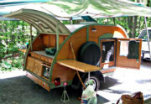I am just in the design stages, just in my head at this point. Why do people insulate their trailers? I live in the North East but do not likely see myself camping in the winter, but in the fall and spring probably.
If my construction was 3/4" plywood for the sides and luan and stringers for the roof why insulate the roof? I was thinking I could give it a post and beam look to the roof.
I also noticed some people insulate the floor, again is this really needed?
With 3/4" for the walls, or even 1/2" why insulate the walls?
What about Pressure Treated floor plywood versus exterior grade with some kind of roof tar or underbody coating? What is the norm or the pros and cons? I was also thinking about the framing members under the ply wood same thing P.T. or coat?
Thanks
Stan
Why insulate and using Pressure treated for the bottom
14 posts
• Page 1 of 1
Stan,
Don't forget the heat. A lot of tear owners live in hot climates and want to keep the cooler air in.
I am a new teardrop owner and my tear is not insulated but from what I have read here insulation can cut down on condensation that sometimes accumulates inside a tear while occupied. Another reason may be to make the cabin quieter.
The way I look at it is if you are running electric and/or plumbing and are using a double wall to hide your lines, you may as well insulate.
For most practical purposes I don't think insulation is necessary.
Pressure treated wood emits toxic vapors and therefore may not be a good choice for a small, occupied area. Since the floor is likely to be covered, it may not be a big issue but I think that many people just don't want to risk it.
Don't forget the heat. A lot of tear owners live in hot climates and want to keep the cooler air in.
I am a new teardrop owner and my tear is not insulated but from what I have read here insulation can cut down on condensation that sometimes accumulates inside a tear while occupied. Another reason may be to make the cabin quieter.
The way I look at it is if you are running electric and/or plumbing and are using a double wall to hide your lines, you may as well insulate.
For most practical purposes I don't think insulation is necessary.
Pressure treated wood emits toxic vapors and therefore may not be a good choice for a small, occupied area. Since the floor is likely to be covered, it may not be a big issue but I think that many people just don't want to risk it.
Last edited by BillZ on Sat Jun 25, 2011 5:13 pm, edited 1 time in total.
-

BillZ - The 300 Club
- Posts: 308
- Images: 0
- Joined: Tue Feb 16, 2010 7:39 pm
- Location: College Park, Maryland


